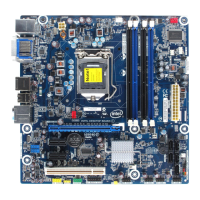Desktop Board Features
17
Digital Visual Interface (DVI-I)
The DVI-I port supports both digital and analog DVI displays. The maximum
supported resolution is 1900 x 1200 (WUXGA). The DVI port is compliant with the
DVI 1.0 specification. The DVI analog output can be converted to VGA using a DVI-
VGA converter.
Depending on the type of add-in card installed in the PCI Express x16 connector, the
DVI port will behave as described in Table 4.
Table 4.
DVI P
ort Status Conditions
PCI Express x16 Connector Status
DVI Digital Port
Status
DVI Analog Port
Status
(Note)
No add-in card installed Enabled Enabled
Non-video PCI Express x1 add-in card
installed
Enabled Enabled
PCI Express x16 add-in card installed Disabled Disabled
Note: DVI analog output can be converted to VGA with a DVI-VGA converter.
VGA Displays
The DVI-I port supports VGA displays when a DVI-I to VGA converter is used. The
maximum supported resolution is 2560 x 1600 (WQXGA).
The DVI-A port is enabled for the POST whenever a monitor is attached, regardless of
the HDMI connector status.
PCI Express* x16 Graphics
The Intel Core i7, Intel Core i5, Intel Core i3, and Intel Pentium processors in an
LGA1156 socket support discrete add-in graphics cards via the PCI Express 2.0 x16
add-in card connector. The board supports the following PCI Express speeds:
• PCI Express 2 frequency of 2.5 GHz which results in 5.0 Gb/s in each direction
(500 MB/s) per lane. The maximum theoretical bandwidth on the interface is
8 GB/s in each direction, simultaneously, when operating in x16 mode.
• PCI Express 1.1 frequency of 1.25 GHz resulting in 2.5 Gb/s each direction
(250 MB/s) per lane. The maximum theoretical bandwidth on the interface is
4 GB/s in each direction, simultaneously, when operating in x16 mode.

